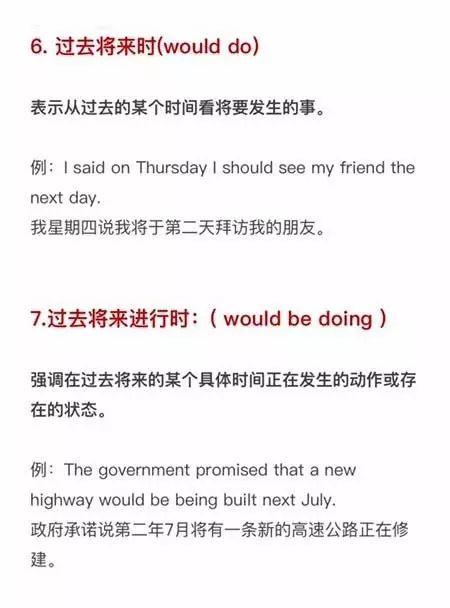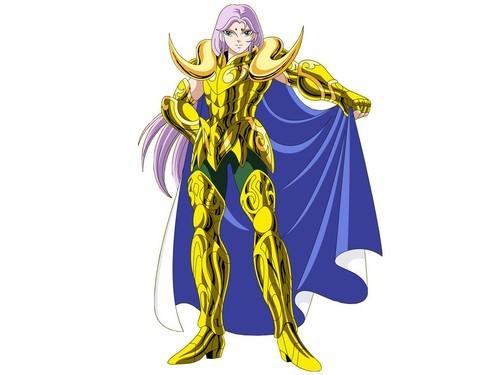时态是英语中一个重要的语法范畴,它表示不同时间发生的动作或存在的状态以及动作发生或存在的方式。动作发生的时间可分为现在、过去、将来和过去将来四种形式,动作发生的方式可分为一般、完成、进行和完成进行四种形式。将这时间形式和动作方式结合起来,就构成了以下16种时态形式(以do为例):
一 般
完 成
进 行
完 成 进 行
现 在
现在一般时
do
现在完成时
have done
现在进行时
is doing
现在完成进行时
have been doing
过 去
过去一般时
did
④现在进行时与频度副词连用,表示说话者或褒义或贬义的感情色彩。
例: He is always helping others.
他总是帮助别人。(褒义)

④过去进行时和频度副词连用可以表示说话者或褒义或贬义的感情色彩。
例:When he lived in country,he was always helping the poor.
住在乡下时,他总是帮助穷人。
4. 一般将来时
①基本结构是will do。
例:We will send her a glass hand-made craft as her birthday gift.
我们将送给她一个玻璃的手工制品,作为给她的生日礼物。
②表示“打算…,要…”时,可用 am/is/are going to do。
例:This is just what I am going to say.
这正是我想说的。
③ 表示“即将、正要”时,可用am/is/are about to do。强调近期内或马上要做的事。
例:Don't worry, I am about to make a close examination on you.
别担心,我马上就给你做一次仔细的检查。
④"be to do"的2种用法:
a) 表示“按计划、安排即将发生某事或打算做某事”。
例:She is to be seen in the lab on Monday.
星期一你准会在实验室见到她。
b) 该做或不该做的事情(语气上接近于should, must, ought to, have to),表示一种命令、规劝性语气。
例:You are to go to bed and keep quiet, kids. Our guests are arriving in less than 5 minutes.
孩子们,你们必须 上床睡觉,不准吵闹。我们的客人5分钟之内就要到了。
5. 将来进行时(will be doing)
强调在将来的某个具体时间正在发生的动作或存在的状态。
例:Don't worry, you won't miss her. She will be wearing a red T-shirt and a white skirt at that time.
别担心,你不会认不出她的。她到时会穿一件红色的T恤衫和一条白色的短裙。

8. 一般过去时 (did; was/were)
①表示过去某个时间发生的动作或情况。
例:I bought some fruits yesterday.
我昨天买了一些水果。
②表示过去习惯性动作。
would/ used to do:过去常常......
例:The old man would sit on a bench in the quiet park and look at others for hours without doing anything or talking to anybody.
老人过去常常坐在宁静的公园里的一条长椅上,看着其他的人,一坐就是数个小时,什么也不干,也不和任何人交谈。
He used to visit his mother once a week.
他以前总是每周看望一次他的母亲。
9. 现在完成时(have/has done)
①表示动作到现在为止已经完成或刚刚完成,强调对现在产生的影响。
例:I bought a new house, but I haven't sold my old one yet, so at the moment I have two houses.
我买了一所新房子,但是还没有卖掉旧的,所以现在我又两所房子。
②表示从过去某时刻开始,持续到现在的动作或情况,并且有可能会继续延续下去。此时经常用延续性动词。
时间状语常用since加一个过去的时间点,或for加一段时间,或by加一个现在时间。
例:Great as Newton was, many of his ideas have been challenged today and are being modified by the work of scientists of our time.
虽然牛顿是个伟大的人物,但他的许多见解直到今天还在受到挑战,并且被现代科学家的工作所修正。
10. 现在完成进行时(have/has been doing)
表示某一动作开始于过去某一时间,延续或重复地出现至今,或将继续延续至将来。
例:We have been working on this project for over a month now.
到目前为止,我们一直在处理那个项目,已经花了一个多月时间了。
11. 过去完成时(had done)
①表示在过去的某个时间或动作以前已经完成的动作或已经存在的状态。就是我们常说的"过去的过去"。
Until then, his family hadn't heard from him for six months.
到那时为止,他家里已经有六个月没得到他的消息了。
②表示从过去的过去开始,持续到过去的动作或情况,并且有可能会继续延续下去。此时经常用延续性动词。
By the time I left the school, he had taught the class for 3 years.
到我毕业时,他已经教那个班三年了.
12.过去完成进行时:had been doing
表示从过去的过去开始,持续到过去的动作或情况,期间一直有规律的在进行、不曾间断,并且有可能会继续延续下去。此时经常用延续性动词。
例:The old clock had been being taken apart of and fixed up again for several times by my 10-year old son before I came back home.
我回到家之前,我10岁大的儿子已经把这个旧钟表拆卸并重新组装了好几回了。

表示动作从过去某一时间开始一直延续到过去将来某一时间,期间一直有规律在进行、不曾间断,并且有可能继续延续下去。
例:They said that by the end of the following month, the project would have been being worked for 3 years.
他们说到第二个月底为止,这项工程就已经不停地进行了3年了。

例:By the end of next month, the project will have been being worked for 3 years.
到下个月底为止,这项工程就已经不停地进行了3年了。
,




